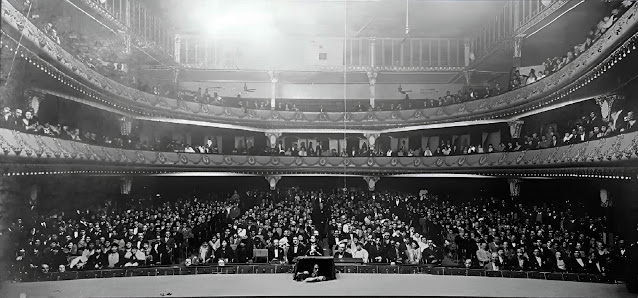Egyptian Belle Époque
A Brief Introduction

Although both Egypt and the French/European Belle Époque converge, there is a bit extra modern layer to the definition which broadly refers to the mid 19th century to
the mid 20th century. In Egyptian Arabic, It is written and pronounced as "El Zamun el-Gameel, الزمن الجميل".
In Egypt, people who lived through periods of the era would recount their stories and have spontaneously coined the term in local culture nearly after 1980. Mr. Samir Raafat is one of those who wrote about it in terms of architecture on October 1, 1998.
One of the prominent manifestations of this era in Egypt is the neo-Mamluk style alongside cosmopolitan architecture:
Window detail of al-Garhee Building, El Lewaa Mohamed Helmi Street, Abbasia, Cairo, 2015. Photo Credit: Bruce Allardice
Side door of Assicurazioni Generali di Trieste Building, Cairo, 2022. Credit: Bruce Allardice
Alexandria, circa 2024
The fashion style of both a
Cairene and a Parisian lady on the magazine
cover of 'Le Chic Oriental', 1926
Egyptian wedding
fashion, 1927. Credit: Adel Safi
Sketch of the scenery for act II of Aïda; entrance to the city of Thebes, 1871. The Opera is composed by Verdi and consists of four acts and seven scenes. Scenery by Auguste Rubé, Philippe Chaperon, Jean-Baptiste Lavastre and Edouard Desfléchin
Sketch of the decoration of act I of Aïda; colonnade opening onto the outside, 1871. Scenery by Philippe Chaperon

The Khedive's State Ball at the Abdeen Palace, Cairo, the Barn Dance.
Illustration by Percy Macquoid. The Graphic newspaper, May 4, 1895
After a Concert, Royal Opera House, Cairo, circa early 1950s
Another cultural manifestation is a flirtatious catch-up phrase: "Bonsoir Ya Hanim!" which translates into "Evening, Madam!"
It was remarked by Egyptian writer, Fikri Pasha Abaza in 1932 as being
"impertinent" if there would be no "prior acquaintance" between the
"young gentleman" and the lady. See Language.
See also:



%20%20side%20door%202022.jpg)











